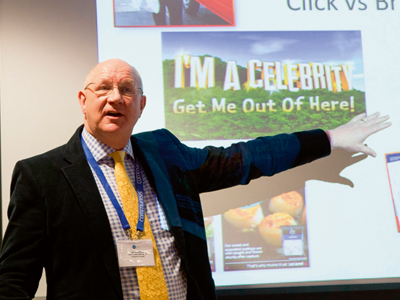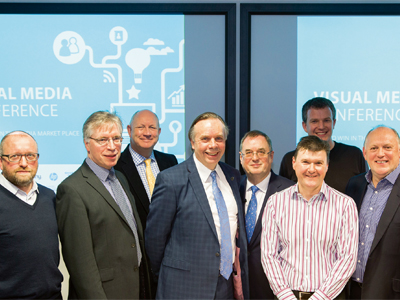A gathering of VMC speakers – from left: David Mihell (Epiphany), Alan McClelland (CPI), Ian Schofield (Iceland Foods), Robert McClements (CDi Yorkshire), Roger Marsh (Leeds City Region Enterprise Partnership), Steve Whiting (Sub@omic), Jon Tolley (Prime Group – back) and Lyle Rainey (HP).
At the Visual Media Conference in Leeds (31st March 2015), delegates heard how the confluence of printing technology and the digital world are impacting on areas such as marketing and packaging. Andy Knaggs reports.
Every human being wants to feel they are different. They want to emphasise it and celebrate it and sometimes accentuate it. It manifests itself in many different ways, just a few of which are our taste in music and fashion, our sporting allegiances, and our preferences for certain brands. All of these things say something about us, and they say something to those who would wish to sell products to us.
If it was possible to glean a common thread from the presentations at the Visual Media Conference 2015, that, it seems to this writer, may be it. What does that have to do with print? In today’s print world of short run, quick turnaround, targeted output, it has a lot to do with it. The Tesco Clubcard statement with its coupons and offers is a prime example, but there is much more to come, both in the transactional and mailing spheres, and in areas such as packaging and labelling, where advances in printing technology are set to wow consumers the world over.
Some of these advances were set out by Lyle Rainey, HP’s UK & Ireland business development manager in his presentation ‘Brands, consumers and communication’, which explored some notable recent ‘adventures in print’ that have taken advantage of digital printing technology. It will be of little surprise that the well-known Coca Cola labels project, digitally printed with first names from across the world, was prominent.
Slightly less well-known is that Coca Cola followed this with its ‘Stay Extraordinary’ campaign, producing two million unique Diet Coke bottle wrappers, with the aim of ‘conveying to Diet Coke lovers that they are extraordinary by creating unique one-of-a-kind extraordinary bottles’. Some of these bottles, now empty of liquid, are apparently selling on the internet for $60. ‘That’s the value of print,’ said HP’s UK & Ireland marketing manager Oana Manolache, who was assisting Mr Rainey.
Further adventures in print included Irn Bru with its 57 clan names and tartan patterns across ten different SKUs, Pernod Ricard offering personalised labels on beverages such as Chivas Regal and The Glenlivet for Fathers’ Day, which resulted in a 6.5% uplift in sales. Boden’s catalogue was personalised to 100,000 dormant customers in an attempt to draw them into re-engaging with the brand – 45% of them have done so.
The ability to be relevant and target people with information and imagery is a very powerful tool, but while the technology is important, this is really about the brands, said Mr Rainey. He revealed details of an event that HP held in Barcelona recently, attended by 50 marketing or agency people from 37 different brands, including names such as Boots, Nestlé, Heinz, Selfridges and Waitrose. The attendees were split into groups and tasked with designing a range of collateral – flexible packaging, labels, POS and folding carton – for an imaginary drinks brand. These were then quickly turned around on the HP Indigo kit on site. ‘It was a clever way to get them engaged,’ said Mr Rainey. ‘It is about exciting the market by making sure that people understand what can be done out there.’ The postscript to the event is that 19 of these brands are now looking to work with HP on their next campaigns.
The HP executives were joined by Jon Tolley of Prime Group, who is also the EMEA director of the HP Indigo user group Dscoop. He sought to look at this rampaging innovation demanded by brands from the perspective of the print service providers that need to deliver these projects. In this regard, he said, Dscoop, with its global network, is invaluable. ‘Very often the challenges we have as a sector are being delivered in some part of the world by someone. Sharing experiences and best practice – that’s invaluable to me,’ he said.
He went on: ‘Brands are not local, the creative industry is not local anymore. We are dealing with brands that are global and part of their and our challenge is how to develop content on a global level effectively. I can connect with 8000 print providers around the world and deliver print that is the same colour and quality, and do it very quickly.’
Lighting it up
From Stefan Casey of academic body The Retail Institute came the added dimension of sensory experience for consumers. They like experiences and excitement, and print has a key role in engaging the senses – not just the visual but the tactile and the scented, things such as scratch and sniff, which is starting to take off, and different materials and different finishes to interest and excite the touch. Inductive inks have been used by Bombay Sapphire to light up its packaging. Advances in flexible batteries will make applications such as this more affordable, he said.
‘Will it make you buy? We are working with printing ink manufacturers and printers to draw up an argument to take to brand owners, to say: if you spend a bit more on print you will sell more.’
At the sharp end of the packaging skirmish is Iceland Foods’ Own Label manager, Ian Schofield, who entertained the audience with an upbeat dash through the issues the supermarket is facing as it seeks to bridge the gap between the ‘destination grocers’ such as Tesco, and the ‘high street discounters’ such as Aldi and Lidl, while making sense of a supply chain that has to cope with an ever-expanding product range. Digital print has been a key factor as the supermarket tries to imitate a speedboat in comparison to the slow-turning container ships that are some other retailers.

Iceland Foods’ Own Label manager, Ian Schofield
‘We change products and the look and feel so quickly. I have more and more SKUs and I never print the same job twice, never have the same job next year. When you have 1500 SKUs, that’s a lot to change every year.’
It means small print runs, last minute changes, more promotion, more legislation to comply with, no stock holding and no write-offs. Digital printing means no flexo plate costs and faster time to market. He concluded: ‘How do we make a difference? Through this disruptive medium we call packaging, and we are going to drive it and drive it.’
It is expected that Near Field Communication and printed electronics will make more and more of an impact in packaging, amongst many other applications, and Alan McClelland, commercial manager at CPI (the Centre for Process Innovation) made the point that while the ‘bling’ of the impact on the consumer of an innovative smart packaging idea is nice to have and may result in increased sales, and that interaction with smart phones for things such as coupons and loyalty schemes is useful, what will really make printed electronics in packaging worthwhile for retailers is more prosaic: track and trace, brand protection/anti-counterfeiting, optimising stockholding and supply chain management.
Moment of epiphany
The second half of the Visual Media Conference departed from the more print-based themes of the first sessions, and instead looked at this issue of difference from the perspective of data and the digital world.
David Mihell, director of Insight at the digital agency Epiphany, asked whether marketing is making the most of difference, in the context that people like to be different, they have more opportunity to be different and express that difference through today’s plethora of media channels, and are encouraged to do so by brands. There are three main ways to make the most of difference he said:
Letting people express themselves Working out what people want and giving it to them Finding and nurturing a community
Among examples of this in practice are the Dancing Pony adverts by mobile network 3, where not only has the video been seen 10 million times on YouTube but the brand also followed it up with an online tool called the Pony Mixer, allowing people to remix the advert; this has been used 1.3 million times. Amazon’s practice of suggesting additional purchases based both on previous purchases and those made by others with ‘similar’ interests is another, as is the elite ‘Marmarati’ – a highly exclusive group of Marmite lovers who network to stir up new ideas and have even been known to sport a Marmite tattoo to prove their love of the love-it-or-hate-it food spread.
That kind of tribalism was explored in a very different way by Alex Craven of digital agency Bloom, who looked at brand influence through social data. A research project has looked at the Tweet mentions of a number of leading brands, including football teams and retailers. The object was to see if this could replace techniques such as focus groups, panels and unprompted brand recall as an accurate measure of the feelings toward a brand. It found that a simple count of Tweets could not provide a real indication. It is possible to run algorithms that look at the sentiment of a Tweet for positives and negatives. However, with every brand studied the positives and negatives invariably cancelled each other out. Bloom then looked at who was driving the discussions, positive and negative, and found that a small number of influencers were active. Combining all of these factors enabled Bloom to quantify the emotional connection that a brand causes in a community.
In closing, CDi Yorkshire said that attendance was up by a third on 2014, with 135 delegates in all. ‘The conference was a great success,’ said Robert McClements, chief executive officer of CDi Yorkshire. ‘It reinforces the message that the region is serious about the role of the Creative and Digital sector.’





